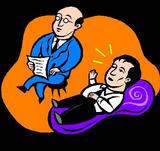Mental Health Resources
Information About Mental Illness
Mental illnesses include such disorders as schizophrenia, schizoaffective disorder, bipolar disorder, major depressive disorder, obsessive-compulsive disorder, panic and other severe anxiety disorders, autism and pervasive developmental disorders, attention deficit/hyperactivity disorder, borderline personality disorder, and other severe and persistent mental illnesses that affect the brain.
These disorders can profoundly disrupt a person's thinking, feeling, moods, ability to relate to others and capacity for coping with the demands of life.
Mental illnesses can affect persons of any age, race, religion, or income. Mental illnesses are not the result of personal weakness, lack of character, or poor upbringing.
Mental illnesses are treatable. Most people with serious mental illness need medication to help control symptoms, but also rely on supportive counseling, self-help groups, assistance with housing, vocational rehabilitation, income assistance and other community services in order to achieve their highest level of recovery.
Eating Disorders
Anorexia is characterized by a significant weight loss resulting from excessive dieting. Most women and an increasing number of men are motivated by the strong desire to be thin and a fear of becoming obese. Anorexics consider themselves to be fat, no matter what their actual weight is. Often anorexics do not recognize they are underweight and may still "feel fat" at 80 lbs. Anorexics close to death will show you on their bodies where they feel they need to lose weight. In their attempts to become even thinner, the anorexic will avoid food and taking in calories at all costs, which can result in death. An estimated 10 to 20% will eventually die from complications related to it.
Bulimia is characterized by a cycle of binge eating followed by purging to try and rid the body of unwanted calories. A binge is different for all individuals. For one person a binge may range from 1000 to 10000 calories, for another, one cookie may be considered a binge. Purging methods usually involve vomiting and laxative abuse. Other forms of purging can involve excessive exercise, fasting, use of diuretics, diet pills and enemas.
Binge eating disorder is characterized by consuming large quantities of food in a very short period of time until the individual is uncomfortably full. Binge eating disorder is much like bulimia except the individuals do not use any form of purging (i.e. vomiting, laxatives, fasting, etc.) following a binge. Individuals usually feel out of control during a binge episode, followed by feelings of guilt and shame. Many individuals who suffer with binge eating disorder use food as a way to cope with or block out feelings and emotions they do not want to feel. Individuals can also use food as a way to numb themselves, to cope with daily life stressors, to provide comfort to themselves or fill a void they feel within. Like all eating disorders, binge eating is a serious problem but can be overcome through proper treatment.
Compulsive overeating is characterized by uncontrollable eating and consequent weight gain. Compulsive overeaters use food as a way to cope with stress, emotional conflicts and daily problems. The food can block out feelings and emotions. Compulsive overeaters usually feel out of control and are aware their eating patterns are abnormal. Like bulimics, compulsive overeaters do recognize they have a problem.
Self-Injury
Self-injury is the act of deliberately destroying body tissue, at times to change a way of feeling. Self-injury is seen differently by groups and cultures within society. This appears to have become more popular lately, especially in adolescents. The causes and severity of self-injury can vary. Some forms may include:
- carving
- scratching
- branding
- marking
- picking, and pulling skin and hair
- burning/abrasions
- cutting
- biting
- head banging
- bruising
- hitting
- tattooing
- excessive body piercing
Personality Disorders
Personality disorders are pervasive chronic psychological disorders, which can greatly affect a person's life. Having a personality disorder can negatively affect one's work, one's family, and one's social life. Personality disorders exists on a continuum so they can be mild to more severe in terms of how pervasive and to what extent a person exhibits the features of a particular personality disorder. While most people can live pretty normal lives with mild personality disorders (or more simply, personality traits), during times of increased stress or external pressures (work, family, a new relationship, etc.), the symptoms of the personality disorder will gain strength and begin to seriously interfere with their emotional and psychological functioning.


